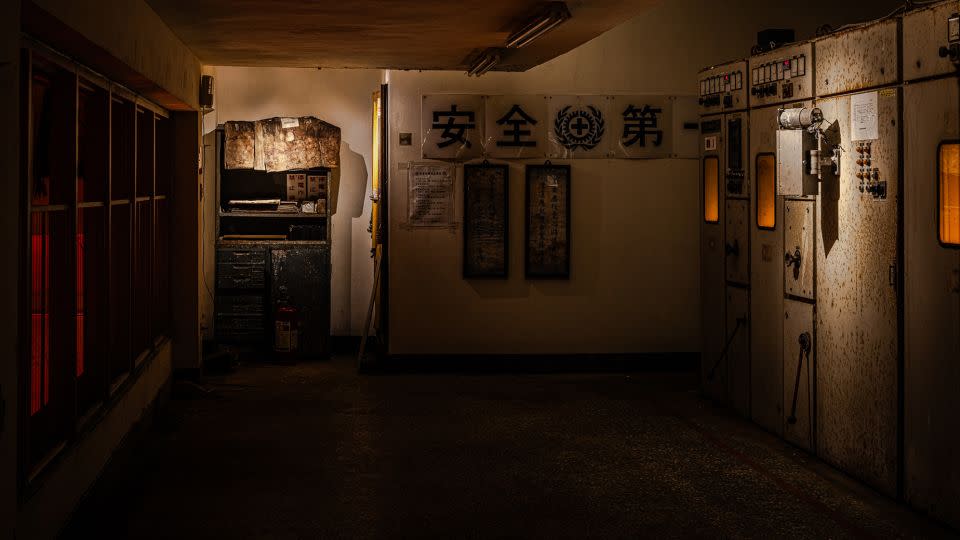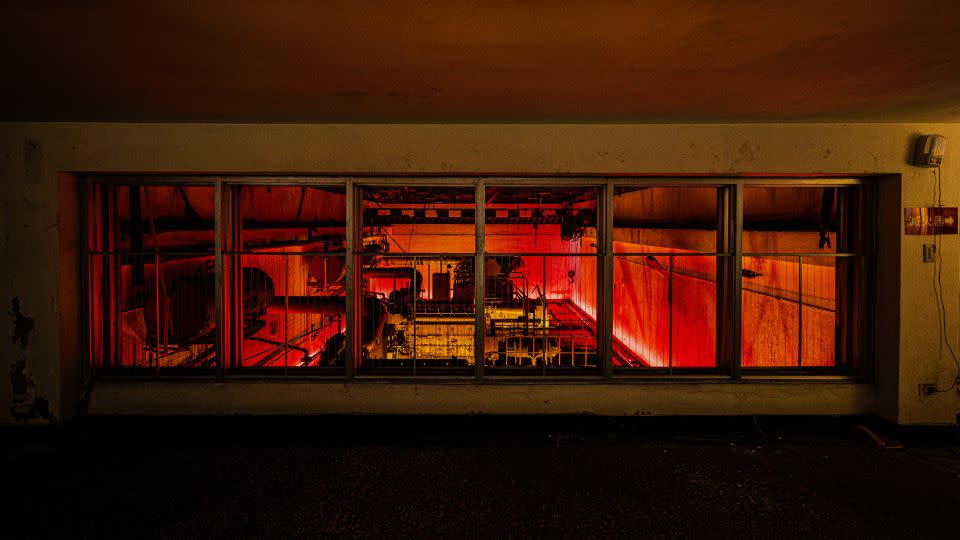Secretive power plant in Taiwan opens to public for the first time — as an art space
In a sleepy Taiwanese island village just eight miles off the coast of mainland China, scooters whiz past an unassuming building that has stood here, largely overlooked, for decades.
As far as residents of Beigan — part of the outlying archipelago of Matsu — are concerned, the structure houses the entrance to a decommissioned Cold War-era thermal power plant dug deep into a mountain. But with the site designated a restricted area by Taiwan’s military, few had ever seen inside of the secretive facility.
That was until late September, however, when the plant was opened to the public for the first time since it was commissioned nearly 50 years ago, as part of the Matsu Biennial. Transforming the facility into a futuristic cyberpunk art space, the installation aims to shine a light on Matsu’s history as a military outpost on the frontline of a war that never came — or at least, one that hasn’t come yet.

Known locally as Jun Hun (or “Army Soul”), a nickname shared with the Taiwanese army division that built it, the Beigan Power Plant entered service in 1975 and became a linchpin of the local economy before closing in 2010. “It changed the residents’ lives on the island forever,” read a recent article by the state-run Matsu Daily.
When the nationalist Kuomintang (KMT) forces retreated to Taiwan in 1949, following defeat to Mao Zedong’s insurgent communists in the Chinese Civil War, it retained control of Kinmen and Matsu — archipelagos lying hundreds of miles from Taiwan’s capital, Taipei, but just across from the shores of mainland China. Shadows of war have hung over the islands for decades; between the 1950s and 1979, the Chinese People’s Liberation Army sporadically bombarded them with artillery shells.
To protect their new power plant from shelling, the KMT dug deep into Matsu’s craggy mountains and built it in a concealed military tunnel — allowing the facility to not only generate electricity but also to serve as an air-raid shelter for residents.
With a thaw in cross-strait relations at the turn of the century, the plant was decommissioned and has stood as a Cold War relic ever since.
Art in the ‘heart’ of Matsu
The transformed Beigan Power Plant is the flagship venue of the Matsu Biennial, which runs through November 12 and features artworks exploring the outlying islands’ heritage, cultural identity and military past. To enter the installation, visitors are ushered into a narrow tunnel equipped with industrial lamps that emanate a warm glow.
Upon reaching a control room overlooking the engine room, they are met by somber red lights marking the perimeter of the space. Orange lights projected onto the power generators themselves accentuate the rusty metal of the machinery.

The lighting designers behind the art installation, Annie Chu and Liu Ping-yi, told CNN in a joint interview that the lamps’ arrangement and low-temperature colors were designed to evoke the feeling that the power plant is still in operation.
“The power plant is the heart of Matsu that hasn’t stopped beating, and the generators are the essence of the power plant,” Liu said told CNN at the studio he shares with Chu.
Amid ongoing hostility from across the strait, Matsu and Kinmen were both under military rule for more than three decades until 1992, many years after martial law was lifted in the rest of Taiwan. Various aspects of people’s everyday lives were regulated, with curfews in place and movements tightly restricted. Residents were even prohibited from owning basketballs or turning on lights at night, in case they attracted enemy attention.
“We want to use lighting to bring viewers back in time,” Liu added. “We want them to think about how tense the atmosphere was and how scarce resources were in Matsu.”
This visual experience is complemented by a soundtrack combining the deafening rumbling of power generators with the buzzing of electrical currents and piano music, an audio experience created by sound artist and composer Wang Yu-jun.
“I want to use sound to breathe new life into the deserted power plant, so that viewers can grasp what it was like when these generators were still running,” Wang told CNN at her studio.

By simulating the deafening sound of a power plant, the installation also intends to pay tribute to the employees who worked there, some of whom suffered hearing damage due to their prolonged exposure to high noise levels, according to Wang.
Beijing has long claimed Taiwan as its own territory and, despite having never controlled the island, has not ruled out taking it by force. In recent years, it has increased economic, military and diplomatic pressure against the island democracy of 24 million, sending fighter jets almost daily into Taiwan’s air defense identification zone.
In a recent spike, China sent more than 100 warplanes close to Taiwan in a 24-hour span in September, prompting the island’s defense ministry to urge Beijing to cease its “persistent military harassment.”
Yet, despite Matsu’s frontline role in ratcheting cross-strait tensions, the artists behind the Beigan Power Plant installation insisted that politics did not influence their work, which is simply about “revisiting” the area’s past.
“We hope viewers will reflect on Matsu’s memories,” Chu said.
The Matsu Biennial runs through Nov. 12, 2023.
For more CNN news and newsletters create an account at CNN.com